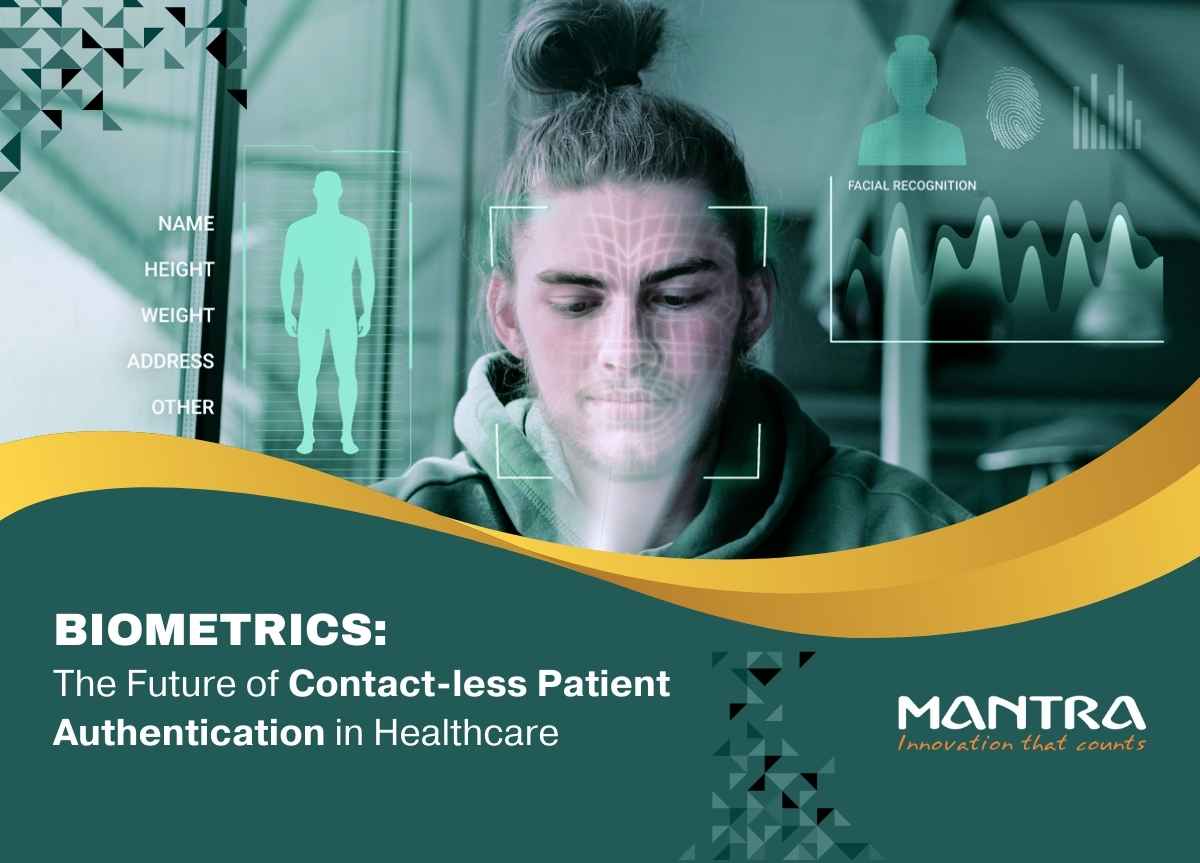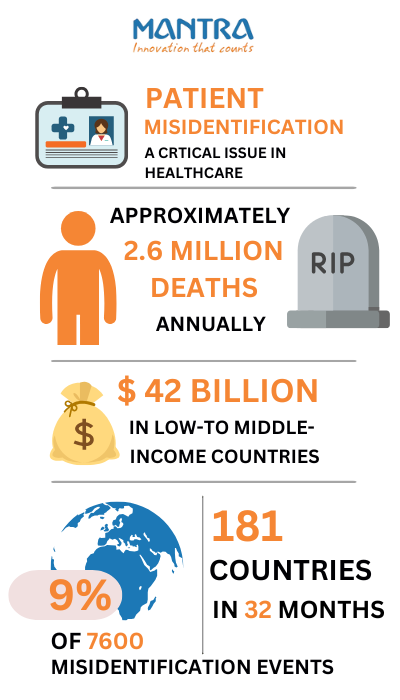Biometrics: The Future of Contact-less Patient Authentication in Healthcare

What if every hospital visit meant no paperwork, no waiting, and no confusion over your medical records? Picture this: you walk into a clinic, and instead of fumbling for your ID or answering verification questions, a quick scan of your biometric patient identification instantly confirms your identity. You’re ushered in without delay, and your doctor already has access to your accurate, up-to-date medical history. This isn’t just a futuristic vision—it’s a necessity.

According to the academia research paper, patient misidentification remains a critical issue in healthcare, contributing to approximately 2.6 million deaths annually and costing $42 billion in low- to middle-income countries.
Due to the patient misidentification, 9% of 7600 patient misidentification event occurred in 181 countries in the span of 32 months. While traditional methods like wristbands are commonly used for biometric patient ID, they can be misplaced or contain inaccurate information, leading to serious consequences such as incorrect treatments, wrong-site surgeries, and even preventable deaths. This is where Biometric in hospitalscomes into the picture.
Biometrics in healthcare is revolutionizing patient authentication, ensuring unparalleled accuracy, boosting operational efficiency, and safeguarding sensitive medical information. For healthcare professionals, this shift isn’t just an upgrade—it’s a game-changer. If you haven’t yet explored its potential, now is the time to understand why biometric authentication in healthcare is becoming an indispensable part of modern healthcare. Let’s begin!
Importance Of Biometrics In Healthcare
Healthcare has traditionally relied on manual methods of identification, from ID cards to passwords and PINs. While these systems may have worked for years, they are increasingly falling short in a digital world where every day new threats are evolving. Lost cards, handwritten errors, and fraudulent entries contribute to inefficiencies and, worse, medical mistakes.
Healthcare Biometrics addresses these gaps by using a patient’s unique physical or behavioral traits, such as fingerprint patient identification, facial features, iris patterns, voice, or palm vein, to verify their identity. These systems provide highly accurate, secure, and contactless solutions that eliminate the pitfalls of traditional authentication methods. When lives are on the line, such precision isn’t just helpful; it’s critical.
Practical Benefits of Using Biometric in Healthcare
Biometric data is impossible to replicate. Unlike passwords or ID cards, it cannot be stolen, shared, or forgotten. Healthcare biometrics technologycan drastically reduce issues like identity theft and unauthorized access to sensitive data, making it a game-changer for patient confidentiality and regulatory compliance.
A Better Experience for Patients
Patients already face enough stress by simply seeking medical care. Biometrics for healthcare can eliminate unnecessary challenges by automating tedious processes like check-ins. Instead of waiting in long lines or sorting through forms, patients can complete these steps with a quick scan, offering them a smooth and hassle-free experience.
A Cure for Record-keeping Chaos
Duplicate accounts and mismatched records often plague healthcare facilities, leading to errors and inefficiencies. By linking patient data to a unique biometric patient ID, these risks are greatly reduced. Healthcare professionals gain faster access to complete and accurate records, ensuring better treatment decisions and outcomes.
Robust Contactless Solutions
Recent global health challenges have underscored the importance of biometric authentication in healthcare. Facial or dual iris recognition systems can authenticate patients without physical contact, minimizing the risks of contagion for both healthcare workers and patients.
Cost and Resource Efficiency
Implementing biometrics can streamline patient management. Tasks that previously consumed hours, like manual verification or data entry, become instantaneous. This allows administrative staff to focus on more critical responsibilities, improving overall operational productivity.
Real-World Applications of Biometrics in Healthcare
Biometric technologies are already being implemented in innovative ways across the healthcare industry. Here are several institutions that have implemented biometric healthcare solutions to enhance patient identification, improve security, and streamline operations.
NYU Langone Health, Newyork, USA
NYU Langone Health has adopted Amazon’s palm recognition technology for biometric patient identification for healthcare. Starting in March 2025, patients can scan their palms to verify their identity upon arrival, aiming to expedite the check-in process and reduce reliance on traditional identification methods.
Novant Health, North Carolina, USA
Novant Health implemented the Right Patient® identification system using iris biometric patient identification across its hospitals. This initiative aims to protect patients from issues related to duplicate medical records and overlays, ensure accurate patient identification, and enhance safety.
Geisinger Medical Center, Pennsylvania, USA
Geisinger Medical Center, has integrated facial recognition technology into its biometric patient identification processes. Patients can authenticate their identity by scanning their faces, which helps in accurately matching them with their medical records, thereby enhancing security and reducing errors.
Tan Tock Seng Hospital, Singapore
Tan Tock Seng Hospital utilizes RFID technology for enterprise wide patient location tracking. The system integrates with the patient flow solutions to optimize bed management processes from admission to discharge, enhancing operational efficiency.
Prince Court Medical Center, Kuala Lumpur, Malaysia
Prince Court Medical Centre employs an RFID-based infant safety system to ensure accurate mother-infant matching. This technology enhances infant security by preventing misidentification and ensuring that each infant is correctly matched with their mother.
Operation ASHA, India & Cambodia
Operation ASHA utilizes the eCompliance system, a biometrics-based application, to monitor tuberculosis treatment adherence. Patients' fingerprints are scanned during medication administration, ensuring compliance with treatment protocols and reducing default rates.
These examples illustrate the growing adoption of biometrics in medicine settings worldwide, aiming to enhance patient safety, data accuracy, and operational efficiency.
Challenges and Considerations in Biometric Implementation
Of course, introducing biometrics into healthcare doesn’t come without hurdles. Being mindful of these challenges ensures smoother implementation and long-term success.
Privacy and Security Risks
Biometric security for healthcare is highly sensitive. If breached, it cannot be revised like a password or ID card. Healthcare facilities must prioritize secure data encryption, storage, and compliance with stringent privacy regulations like HIPAA.
Cost of Deployment
While there are significant long-term savings, the initial cost of setting up biometric sensors in healthcare can be high. Technology procurement, staff training, and infrastructure updates need to be aligned with an organization’s budget and vision.
Patient Adoption and Trust
Some patients may be apprehensive about sharing fingerprint technology for healthcare. Education is key to easing these concerns. Conveying how data will be used, stored, and protected can help build trust and encourage adoption.
Interoperability
Many healthcare organizations rely on legacy systems that may not integrate seamlessly with healthcare and hospitals' biometric authentication. An evaluation of the existing IT ecosystem is crucial before planning implementation.
Implementing Biometrics the Right Way
Bringing biometric authentication into your healthcare facility doesn’t just require technology; it requires strategy. Here’s how to do it effectively:
Assess Your Facility’s Needs
Identify challenges within your workflows. High patient volumes, long queues, or frequent record discrepancies could indicate that biometrics in hospitals will add value.
Choosing the Right Biometric System: A Practical Approach
Different biometric modalities have varying use cases. For instance, contactless solutions like facial recognition may be ideal in pandemic-sensitive settings, while fingerprint patient identification may suit smaller clinics.
Ensure Compliance
Work with biometric security in medicine vendors who understand privacy laws and data protection standards in healthcare. Safeguards should be a core component of your healthcare biometric technology.
Prioritize Training and Awareness
It’s not just about installing the technology. Train your staff to use it expertly and communicate its benefits clearly to your patients for seamless on-boarding.
The Future of Healthcare is Biometric
Biometric authentication in healthcare isn’t just a fleeting trend; it’s a paradigm shift. From enhancing security to streamlining operations and improving patient satisfaction, this technology is already demonstrating its value in healthcare systems worldwide. Professionals prepared to adapt and adopt these innovations will lead the charge into a more efficient and secure era.
Are you ready to take the step toward integrating biometrics for healthcare in your facility? The time to act is now. Stay ahead of the curve and transform the way your organization handles patient authentication. Contact us to get started and learn how our solutions can support your healthcare needs.
